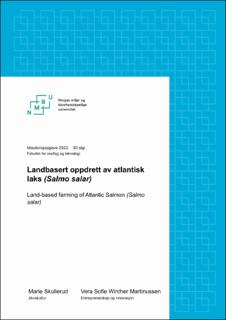| dc.contributor.advisor | Lekang, Odd-Ivar | |
| dc.contributor.advisor | Aarset, Bernt | |
| dc.contributor.author | Skullerud, Marie | |
| dc.contributor.author | Martinussen, Vera Sofie Winther | |
| dc.date.accessioned | 2022-10-20T09:16:25Z | |
| dc.date.available | 2022-10-20T09:16:25Z | |
| dc.date.issued | 2022 | |
| dc.identifier.uri | https://hdl.handle.net/11250/3027243 | |
| dc.description.abstract | Verden trenger mer mat, men produserer per i dag ikke nok. Norge eksporterte 1,4 millioner tonn fra havbruk i 2021. Regjeringen legger til rette for teknologiutvikling som kan ekspandere produksjonen gjennom å utnytte potensialet til marine råstoffer. Dette har ført til at flere bedrifter planlegger å drive med slik produksjon. De senere årene har landbasert lakseoppdrett for matfisk fått økende interesse.
Konvensjonell lakseoppdrett begynner med laks i tanker på land, men flyttes så til merder for å vokse til slakteklar vekt. I merder har man tetthetsbegrensning på 25 kg/m3 og konsesjoner for å drive slik oppdrett er svært kostbart. Det har vært en økning i kostnader per kg produsert laks som følge av økt fôrkostnad og kostnader tilknyttet fiskehelse. Den største utfordringen til konvensjonell lakseoppdrett er lakselus. Bedrifter som flytter hele produksjonen på land møter ikke på de samme utfordringene. Landbaserte akvakulturkonsesjoner er vederlagsfri, og anleggene har større kontroll på hva laksen utsettes for. I landbasert oppdrett benyttes teknologier som resirkuleringssystemer, gjennomstrømming og hybrid, hvor førstnevnte er den dominerende teknologien blant bedrifter.
I Norge er det tre bedrifter som er i aktiv drift med landbasert produksjon av matfisk med atlantisk laks. Til sammen har de en kapasitet på 2 600 tonn. Blant bedrifter som enda ikke er i drift, er det i Norge en planlagt kapasitet på 579 421 tonn sammenlignet med en planlagt kapasitet på 1 119 927 tonn blant bedrifter ellers i verden. I dag produseres 48 657 tonn landbasert atlantisk oppdrettslaks i verden.
For å ha lønnsom drift er man nødt til å ha høy stående biomasse. Av biologiske grunner vil ikke laks i en gruppe vokse likt og variasjon i størrelse gjør det mer utfordrende for oppdretter å planlegge slaktetidspunkt og salg. Flytting og sortering er avgjørende tiltak for å å bedre kontroll på beholdningen og øke omløpshastigheten, da sortering reduserer spredningen. Variasjonskoeffisienten (CV) for en tank blir mindre jo mer man reduserer spredning i størrelse. Samtidig har denne masteroppgaven vist at CV tenderer til å øke når laksens vekt øker. Basert på innhentede data kom oppgaven videre frem til at man kan forvente en CV på 32 i størrelsesorden fem kg. | en_US |
| dc.description.abstract | The world requires more food and is in need of increased food production. Norway exported 1.4 million tonnes from aquaculture in 2021. The Norwegian government is facilitating technology development that can expand production by exploiting the potential of marine raw materials. This has led to several companies planning to engage in such production. In recent years, land-based salmon farming for grow-out has gained increasing interest.
Conventional farming begins with salmon in tanks on land but transfers the fish to cages to grow-out. In cages, there is a density limit of 25 kg/m3 and licenses to conduct such farming are expensive. There has been an increase in costs per kg of salmon produced as a result of increased feed costs and costs associated with fish health. The biggest challenge for conventional salmon farming is salmon lice. Companies that transfer production on land do not face the same challenges. Land-based aquaculture licenses are free of charge and the facilities have more significant control over what the salmon are exposed to. In land-based farming, technologies such as recirculating aquaculture system, flow-through system and hybrid flow-through system are used, whereas RAS is the most dominant technology among companies in the sector.
In Norway, three companies are in active operation with production of land-based grow-out with Atlantic salmon. In total, they have a capacity of 2,600 tonnes. Among companies that are not yet in operation, there is a planned capacity of 579,421 tonnes in Norway, compared with a planned capacity of 1,119,927 tonnes in the world. Today, 48,657 tonnes of land-based Atlantic farmed salmon are produced in the world.
To have profitable operations, one must have a high-standing biomass. For biological reasons, salmon in a group will not grow equally and variation in size makes it more challenging for the breeder to plan the time of slaughter and sale. Moving and sorting are crucial actions to gain better control of the stock and increase the turnover rate, as sorting reduces the spread. The coefficient of variation (CV) for a tank becomes smaller the more you reduce the spread in size. At the same time, this master's thesis has shown that the CV tends to increase when the salmon's weight increases. Based on obtained data, this thesis further inferred that one can expect CV to be 32 when fish weight is approximately five kg. | en_US |
| dc.language.iso | nob | en_US |
| dc.publisher | Norwegian University of Life Sciences, Ås | en_US |
| dc.rights | Attribution-NonCommercial-NoDerivatives 4.0 Internasjonal | * |
| dc.rights.uri | http://creativecommons.org/licenses/by-nc-nd/4.0/deed.no | * |
| dc.title | Landbasert oppdrett av atlantisk laks (Salmo salar) | en_US |
| dc.title.alternative | Land-based farming of Atlantic Salmon (Salmo salar) | en_US |
| dc.type | Master thesis | en_US |
| dc.description.localcode | M-MPP | en_US |

